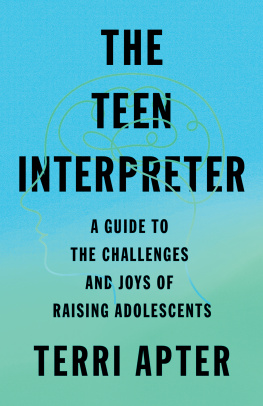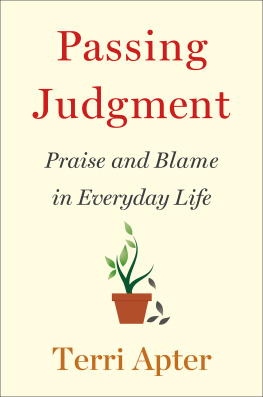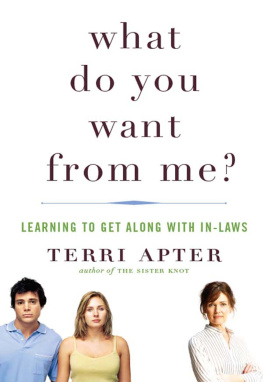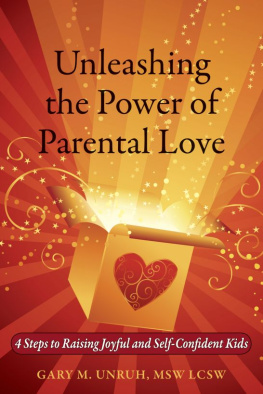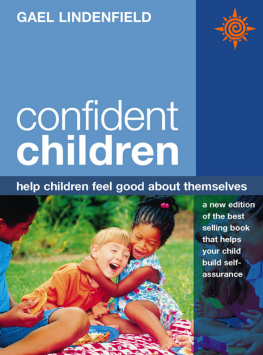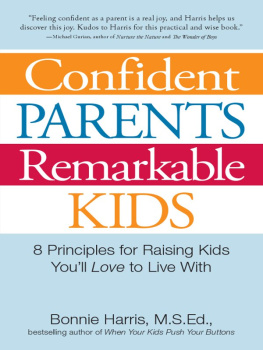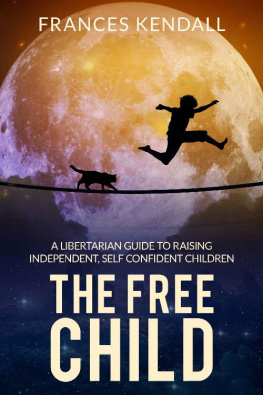
PRAISE FOR THE BOOKS OF TERRI APTER. PH.D.
On The Confident Child:
Convincing, well-written and truly helpfulsuggests concrete ways for parents to help their children like themselves and feel confident.
Publishers Weekly
Terri Apter convinces the reader that she is on our side and even has a useful chapter called How to Be an Imperfect Parent Without Ruining Your Childs Life. Her wisdom is tempered by warmth and a rueful acknowledgment that she hasnt always got it right herself, which is totally disarming.
Mary Hoffman, author of Amazing Grace
On Altered Loves:
Simply wonderfula fresh vision that blows away old stereotypes, dated theories, male biases and familiar patterns of blame. It is a model of lucid research and writing.
The New York Times
On Working Women Dont Have Wives:
She touches a resonant chordprovides a useful focus on the sources of the enormous resistance that makes change so difficult.
The New York Times
A thoughtful analysis of an extraordinarily complex problem.
Kirkus Reviews
On Secret Paths:
Lively and revealingApter also provides insightful passages on the balance of power as it shifts in midlife marriages; on love and disengagement in the relationship between midlife women and their mothers; and on the nature of love and experience as they apply to women at this time in their lives.
The New York Times
An extremely important bookHer writing offers perceptions rare in psychology.
Carol Gilligan
Altered Loves: Mothers and Daughters during Adolescence
Working Women Dont Have Wives: Professional Success in the 1990s
Secret Paths: Women in the New Midlife
The Myth of Maturity: What Teenagers Need from Parents to Become Adults
You Dont Really Know Me: Why Mothers and Daughters Fight, and How Both Can Win
The Sister Knot: Why We Fight, Why Were Jealous, and Why Well Love Each Other No Matter What
for Miranda, Julia, Brian, and Adrienne
I wish to thank the parents and children who attended my workshops in Cambridge, shared their problems, and tested solutions with me. Their optimism, humor, warmth, and trust were crucial to shaping this book. In the course of the past ten years, ongoing conversations with my sister, Marion Quinn, persuaded me that parents needed a book to help them motivate and support their children. Together we mused over the difficulty of sustaining a very young childs exuberant confidence through the challenges of middle childhood. As parents, we felt that in our most important job we faced an obstacle course through which we wanted to preserve a childs goodness, while shaping character. We pooled observations about effective methods of discipline. We wondered how we would sustain our influence as our children made their way in school and among peers. Geographical distance did nothing to impede these conversations, but I wanted to give them a broader canvas and a research-based structure.
This aim was facilitated by conversations I had with Judy Dunn and by her work on the connections between emotion and understanding in development. Her ability to combine theoretical sophistication with day-to-day observations helped structure my sense of the important ways parents can pass on their knowledge about emotions to children. Jim Gilligans searching questions about the importance of self-esteem inspired me at a time when I had only the vaguest notion of embarking on this project. Throughout the past ten years, Nancy Chodorow, Mary Jacobus, Michelle Stanworth, Sandra Gilbert, and Mary Hamer have offered essential reality checks to problems and questions that have arisen in our mutualbut very differentparenting experiences. I see this book not as an end, but as a continuation of such conversations that are going on between parents everywhere.
My agent, Meg Ruley, was always available as a sounding board for my ideas, and her attention has been invaluable. My editor, Jill Bialosky, while experiencing one of the most demanding phases of parenthood herself, continued to parent this project with her expert guidance and support.
one
Confidence for Life
Building Blocks
M any years ago, as a sophomore in college, I worked as an assistant on a study of childrens motivation. My job consisted of greeting the child and parent as they arrived at the research unit, handing the parent a permission and information form to fill in, and seating them in the room in which the study was to take place. After two further parent/child couples went through the same process, I brought out a large box filled with wood blocks of different colors, sizes, and shapes, and explained to the children, who ranged from two to five years of age, that they were to build the best tower they could build with these blocks, and that someone would judge which childs tower was really the best. The parents were then led from the room. I told the children when to begin, when to stop, and gave a signal for the judgea Ph.D. studentto enter. He studied the towers closely, nodded from time to time, muttered to himself, and took notes. He then declared one to be the best or the winning tower. This process was repeated three or four times before the session was declared to be at an end.
This procedure in fact had nothing whatsoever to do with assessing childrens skills in building towers. The declaration that a tower won was random. The aim of the study was to observe childrens responses to success or failure. Their responses were filmed, and then analyzed by the researchers in charge. I did not see the films, but these scenes have never ceased their re-runs inside my mind.
When I began this job, I knew nothing about, and had no feeling for how children liked to be treated, for what adult behavior might be convincing or threatening or disturbing, for how children might be responding to the world around them. But the P.R. part I played was deemed inadequate by my employers for other reasons: I disturbed the study by comforting the losing child; I was insufficiently neutral as I described the process of the game; I sent messages to the children, even before they began, that the game should not be taken seriously.
It was not the youngest children who roused my empathy. The two- and three-year-olds were in some ways hard work, because they often had their own ideas about what they wanted to do with the blocks, or whether they wanted to play with them at all, but on the whole, their winning or losing was of little import to them. Most of these very young children seemed to note their success or failure dispassionately. Oh, they might say, with a shudder of surprise, either to winning or losing; and whether they won or lost, they took great pleasure in demolishing the structure with one swipe. Some who won expressed surprise, and looked at their towers with new respect. A few did, even at age three, seem disappointed or angry. But the crestfallen face or the stamp of rage was transient. Within minutes, they were back into the game. Disappointment simply did not stick to them.
It was the slightly older children whose behavior turned my routine into torture. When these children lost, a cloud descended upon them. One girl sat with her eyes fixed on her tower and touched it gently with the tip of her forefinger, up and down, as though to protect it. When I spoke to her, she seemed too embarrassed to face me. A boy who had constructed his tower with the utmost concentration, knelt beside his losing structure and gazed at it from beneath, humming to himself as he dismantled it, slowly, brick by brick. He then stirred the wooden blocks into a pile as though to remove any sign of his former efforts. After two or three such failures to win, the children became sullen and withdrawn and discouraged. They did not want to build another tower, they lost hope of winning and were irritated by my attempts to encourage them.


